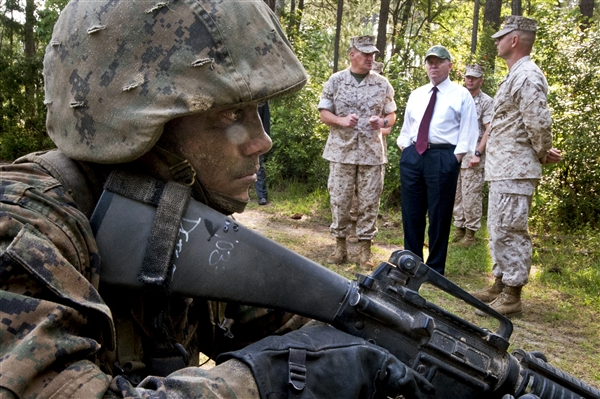WASHINGTON, Jan. 26, 2011 — The Defense Department’s plans to cut $78 billion from its budget over five years and find more than $100 billion in savings for reinvestment was a collaborative effort and a reasonable balance between military needs and budget constraints, Deputy Defense Secretary William J. Lynn III said today.
“Some will argue that our proposals cut defense too much, others will argue it doesn’t cut enough,” Lynn told the House Armed Services Committee. “We believe it strikes the right balance for these difficult times.”
Lynn was accompanied by the vice chiefs of each of the services, each of whom agreed that the budget plans were a collaborative effort that included service leaders.
“We were part of that process and agreed with the decisions that have been made,” Gen. Peter Chiarelli, Army vice chief of staff, said.
Acting on Defense Secretary Robert M. Gates’ directive, the services already have found more than $100 billion in savings. They expect to redirect those savings to spend $70 billion on improved weaponry and technical capabilities and $28 billion on higher-than-expected operating expenses in the next five years, Lynn said.
The Army will realize savings partly from terminating its SLAM-RAM — Standoff Land Attack Missile and Rolling Airframe Missile – programs, as well as its nonline-of-sight air missiles. With the savings, the Army will invest more heavily in Abrams tanks, Bradley fighting vehicles and Stryker wheeled vehicles, Lynn said.
The savings will allow the Navy to buy six more ships, including a destroyer, he said.
Gates made tough decisions, Lynn said, in terminating programs such as a new presidential helicopter, the F‑22 fighter jet, the Future Combat System and the Expeditionary Fighting Vehicle. “The department needs to make hard decisions early on [in procurement], and we are endeavoring to do that,” he said. “We’ve often balanced in favor of performance, but then the budget and the schedule suffers. We’re trying to balance better.”
Quoting Gates’ earlier statements, Lynn said the budget plans represent “reasonable, responsible, and sustainable defense spending for the next five years.”
The budget cuts $78 billion from the department’s top line over five years, giving it a $553 billion baseline budget – a modest increase – for fiscal 2012, Lynn said. The cut was made in keeping with Obama administration efforts to lower the deficit, he said.
“The strength of our national defense depends on a strong economy as well,” Lynn said.
The cuts will mean freezing most civilian personnel hiring through 2013, and cutting the department’s contractor work force by 10 percent for three years, Lynn said.
The department also will seek savings through its TRICARE medical system, for which costs have nearly doubled in 10 years, he said. The budget would lift TRICARE enrollment fees – which have remained unchanged since the program began 15 years ago — for working-age military retirees, stop subsidies to nonmilitary hospitals, and adjust pharmacy co-payments, he said.
Other streamlining measures include closing U.S. Joint Forces Command and merging its essential functions into other areas, eliminating the Business Transformation Agency, and doing away with the position of assistant secretary of defense for network and information integration, Lynn said.
Force structure will grow 2 to 3 percent for fiscal 2012, then decline to the point of no growth in fiscal 2015 and 2016, the deputy secretary said.
Under the plan, the Army would lose 27,000 positions in end strength, and the Marine Corps would lose 15,000 to 20,000. Those reductions would not begin until after U.S. troops are scheduled to leave Afghanistan in 2014, Lynn said, and still would leave end strength higher than it was when Gates took office in December 2006, he said.
Even with the cuts, when the National Guard and Reserve are factored in, the Army will have 47,000 more soldiers in 2015 than it had in 2006, Chiarelli said.
Source:
U.S. Department of Defense
Office of the Assistant Secretary of Defense (Public Affairs)

 von
von 

